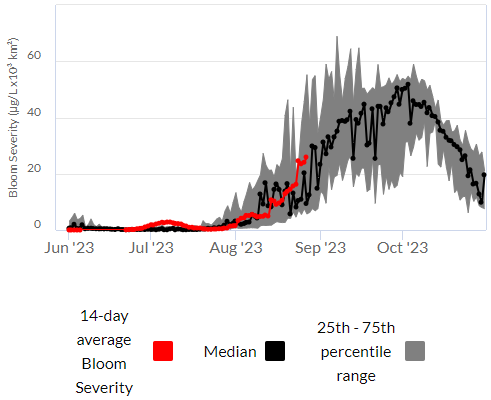 Satellite-derived chlorophyll-a concentrations, indicating algae blooms distribution and intensity on Lake of the Woods, August 27, 2023. EOLakeWatch, Environment and Climate Change Canada.After a hot June but cool and sometimes smoky July, the algae bloom on Lake of the Woods started to develop in late July and early August as usual. Blooms began in the southern Big Traverse Bay and in the Morson-Sabaskong area to the south-east. By late August, the bloom covered 34% of the lake and has progressed northward through middle channel to Oak Point. Satellite-derrived measures of chlorophyll-a (a pigment in the algae) ranged above 40 µg/L (red in the satellite image) indicating severe bloom formation in a few locations (anything above 10 µg/L is considered a bloom). The bloom severity index (red line in graph is tracking close to the average 2002-2022 (black line in graph).
Satellite-derived chlorophyll-a concentrations, indicating algae blooms distribution and intensity on Lake of the Woods, August 27, 2023. EOLakeWatch, Environment and Climate Change Canada.After a hot June but cool and sometimes smoky July, the algae bloom on Lake of the Woods started to develop in late July and early August as usual. Blooms began in the southern Big Traverse Bay and in the Morson-Sabaskong area to the south-east. By late August, the bloom covered 34% of the lake and has progressed northward through middle channel to Oak Point. Satellite-derrived measures of chlorophyll-a (a pigment in the algae) ranged above 40 µg/L (red in the satellite image) indicating severe bloom formation in a few locations (anything above 10 µg/L is considered a bloom). The bloom severity index (red line in graph is tracking close to the average 2002-2022 (black line in graph).
 Satellite-derived bloom severity index (red line) at Aug 27, 2023, compared to 2002-2022 reference data. Dr. Caren Binding, EOLakeWatch, Environment and Climate Change CanadaAlgal blooms in Lake of the Woods typically peak in the late fall, and progress into the north-central area of the lake. Thus, more extensive blooms are expected to come later, expanding in extent and severity into the fall. Last year, peak severity occurred on October 13, 2022. We’ll have a complete report on the annual bloom conditions later in the fall, once the satellite tracking is complete for the season.
Satellite-derived bloom severity index (red line) at Aug 27, 2023, compared to 2002-2022 reference data. Dr. Caren Binding, EOLakeWatch, Environment and Climate Change CanadaAlgal blooms in Lake of the Woods typically peak in the late fall, and progress into the north-central area of the lake. Thus, more extensive blooms are expected to come later, expanding in extent and severity into the fall. Last year, peak severity occurred on October 13, 2022. We’ll have a complete report on the annual bloom conditions later in the fall, once the satellite tracking is complete for the season.
